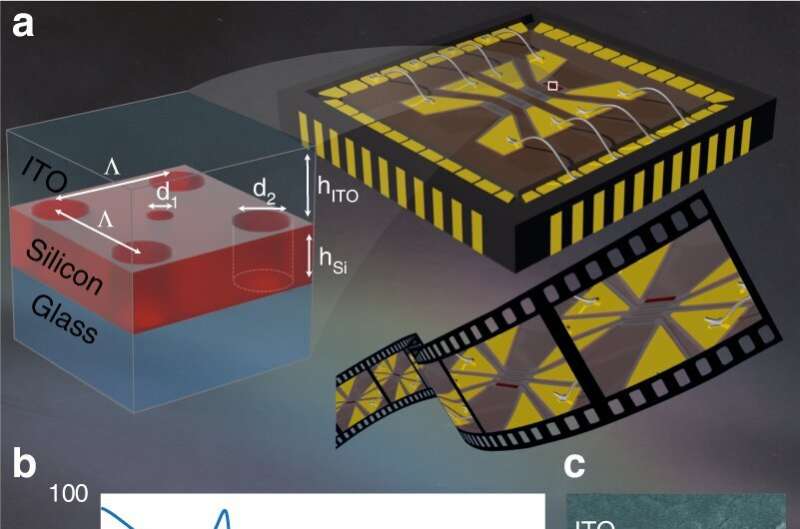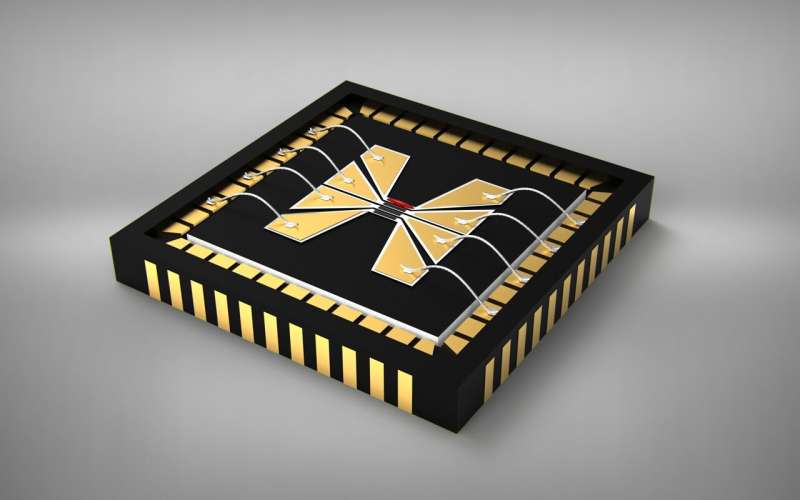This article has been reviewed according to Science X's editorial process and policies. Editors have highlighted the following attributes while ensuring the content's credibility:
fact-checked
peer-reviewed publication
trusted source
proofread
'Metasurfaces' could spark next generation of significantly thinner and cheaper flat screens

Researchers have developed a proof of concept technology that could pave the way for next-generation displays beyond current LCDs and LEDs, enabling screens and electronic devices to become thinner, offer higher resolution and be much more energy efficient.
A team at Nottingham Trent University, the Australian National University and the University of New South Wales Canberra in Australia has engineered electrically tunable arrays of nanoparticles called "metasurfaces," which can offer significant benefits over current liquid crystal displays.
Today's display market offers a large range of choices, each with its pros and cons. However factors including production costs, lifespan and energy consumption have kept liquid crystal technology the most dominant and popular technology for screens such as TV sets and monitors.
Liquid crystal cells are responsible for switching the transmitted light on and off and are lit by a backlight, with polarizing filters in the front and behind the pixels. They determine the dimension of pixels—the resolution—and play a significant role in managing the device's power consumption.

The newly engineered metasurface cells—which have tunability and extraordinary light scattering properties—would replace the liquid crystal layer and would not require the polarizers, which are responsible for a large amount of wasted light intensity and energy use in displays.
The metasurfaces are 100-times thinner than liquid crystal cells, offer a tenfold greater resolution and consume 50% less energy.
As part of the study, the team demonstrated that pixels could be electrically programmed and the light could be switched almost 20 times faster than human aversion response time by changing the temperature of the material.
The researchers believe their technology is compatible with modern electronic displays and fills a technological gap for tunable metasurfaces capable of switching light effectively at high frequencies.
"We have paved the way to break a technology barrier by replacing the liquid crystal layer in current displays with a metasurface, enabling us to make affordable flat screens liquid crystal-free," said the project leader Mohsen Rahmani, Professor of Engineering at Nottingham Trent University's School of Science and Technology and a Royal Society Wolfson Fellow.
He said, "The most important metrics of flat panel displays are pixel size and resolution, weight and power consumption. We have addressed each of these with our meta-display concept.
"Most importantly, our new technology can lead to a huge reduction of energy consumption—this is excellent news given the number of monitors and TV sets being used in households and businesses every single day. We believe it is time for LCD and LED displays to be phased out in the same way as former cathode ray tube (CRT) TVs over the past ten to 20 years."
Dragomir Neshev, Director of the ARC Center for Excellence in Transformative Meta-Optical Systems (TMOS) and Australian National University Professor in Physics, said, "The capability of conventional displays has reached its peak and is unlikely to significantly improve in the future due to multiple limitations. Today there is a quest for fully solid-state flat display technology with a high-resolution and fast refresh rate. We have designed and developed metasurface pixels that can be ideal for the next-generation display.
"Unlike liquid crystals, our pixels do not require polarized lights for functioning, which will halve screens' energy consumption."
Khosro Zangeneh Kamali, a Ph.D. scholar at the Australian National University and the first author of the study, said, "Metasurfaces are proven to exhibit extraordinary optical behavior. However, inventing an effective way to control them is still a subject of heavy research. We have proposed electrically programmable silicon metasurfaces, which is a versatile platform for programmable metasurfaces."
Dr. Lei Xu, a team member from Nottingham Trent University, said "There is significant room for further improvements by employing artificial intelligence and machine learning techniques to design and realize even smaller, thinner and more efficient metasurface displays."
Professor Andrey Miroshnichenko, a team member from the University of New South Wales Canberra, said, "Our pixels are made of silicon, which offers a long life span in contrast with organic materials required for other existing alternatives. Moreover, silicon is widely available, CMOS compatible with mature technology, and cheap to produce."
He concluded that it was hoped the development could generate a frontier technology in new flat displays. The work is reported in the journal Light: Science & Applications.
More information: Khosro Zangeneh Kamali et al, Electrically programmable solid-state metasurfaces via flash localised heating, Light: Science & Applications (2023). DOI: 10.1038/s41377-023-01078-6




















